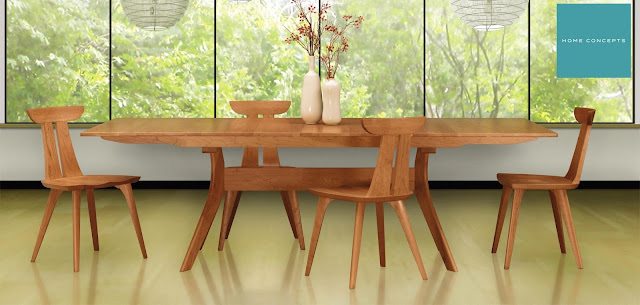How to Choose the Perfect Dining Table for Your Home
The dining table is more than just a place to eat; it’s the heart of family gatherings, social events, and daily conversations. Choosing the perfect dining table for your home involves careful thought, and balancing function with design. Whether you’re looking for a compact piece for a small apartment or a hardwood dining table for a spacious dining room, this guide will help you make the right choice.
Assess Your Dining Room Size and Shape
Before you begin browsing through different styles, the first step in selecting the perfect dining table is understanding the size and shape of your dining space. Measure the room’s dimensions, noting any permanent fixtures such as windows, doors, or other furniture that may influence the table's placement.
- Rectangular rooms typically suit rectangular or oval tables, which maximise seating and space.
- Square rooms often look more balanced with round or square tables, enhancing symmetry.
- Small or narrow spaces may require compact, extendable tables or those with drop leaves that can expand when needed.
A general rule is to allow at least 3 feet of space around the table so that chairs can be pulled out easily, ensuring both comfort and flow within the room.
Determine the Seating Capacity
How many people do you usually host? Dining tables come in various sizes, accommodating different numbers of people. If you often have guests over or have a large family, a larger custom dining tables is necessary. However, for couples or smaller households, a table for four or six may suffice.
- Rectangular tables: Seats 4-6 people comfortably with a length of about 5-6 feet, while longer tables can seat up to 10 or more.
- Round tables: Can seat 4-6 people comfortably if it's about 48 inches in diameter.
- Extendable tables: Offer flexibility, providing extra seating when needed while keeping the space manageable daily.
Think about your lifestyle. If you entertain frequently, consider an extendable table for versatility.
Choose the Right Table Shape
The shape of your dining table can significantly impact how it fits into your space and interacts with your home's overall design. Here’s a breakdown of popular table shapes:
- Rectangular: This is the most common dining table shape. It works well in longer rooms and allows for the maximum number of seats.
- Square: Square tables are perfect for square rooms, creating a balanced and intimate feel. However, they’re less ideal for larger gatherings.
- Round: Round tables encourage conversation as everyone can see each other, and they’re great for small dining spaces. A round pedestal base is especially useful in tight quarters.
- Oval: An oval table is a space-saving alternative to rectangular tables, offering the same seating capacity but with a softer edge, which works well in narrower rooms.
Consider the Table Material
The material of your dining table will influence its durability, maintenance needs, and style. Here are some popular options:
- Wood: Wood is classic and versatile, with options like oak, walnut, and mahogany adding warmth and natural beauty to your space. Solid wood tables are durable but may need refinishing over time.
- Glass: Glass tables are sleek and modern, making a room feel larger and lighter. However, they require frequent cleaning as smudges and fingerprints are more visible.
- Marble: Marble is luxurious and timeless, perfect for formal dining rooms. It’s durable but can be porous, so it requires regular maintenance to prevent stains.
- Metal: Metal tables are often paired with industrial or contemporary designs. They’re sturdy but can feel cold, so they may not suit every home’s aesthetic.
- Laminate: Laminate or veneer tables mimic the look of wood or stone but are more affordable. They’re easy to clean but might not last as long as solid wood or natural stone options.
Evaluate the Base Design
The hardwood dining table base impacts both the look of the table and how many people it can comfortably seat. Different base designs have unique advantages:
- Four legs: The most traditional design. However, the placement of the legs can restrict seating arrangements.
- Pedestal: A central pedestal provides more legroom and flexibility with seating since there are no corner legs to work around.
- Trestle: Common in farmhouse and rustic designs, the trestle base offers stability and can comfortably seat more people.
Consider how the base will affect chair placement and the overall look of the room.
Complement Your Home's Style
Your dining table should reflect your home’s overall design style. A table that complements your interior can elevate the entire space.
- Modern homes: Sleek lines, minimalist designs, and materials like glass, metal, or marble.
- Traditional homes: Solid custom dining tables with intricate details, perhaps with a rich finish.
- Rustic or farmhouse styles: Reclaimed wood tables, trestle bases, or tables with a distressed finish.
- Industrial spaces: Metal frames, exposed bolts, and raw wood surfaces.
Match Your Dining Chairs
Once you’ve chosen your table, think about the dining chairs. You can either buy a matching set or mix and match it for a more eclectic look. Ensure that the chairs are the right height for the table — the ideal distance between the seat of the chair and the tabletop is around 10-12 inches.
Consider adding cushions or upholstered chairs for extra comfort, particularly for longer meals or gatherings.
Summing Up
Choosing the perfect dining table for your home is a blend of practicality and aesthetics. By considering the size and shape of your room, the number of people you usually host, your preferred material, and your home’s overall style, you’ll find a table that not only fits your space but enhances it.
A hardwood dining table is more than just a piece of furniture — it’s where memories are made, so take your time to choose one that reflects your lifestyle and taste.
.jpg)



Comments
Post a Comment